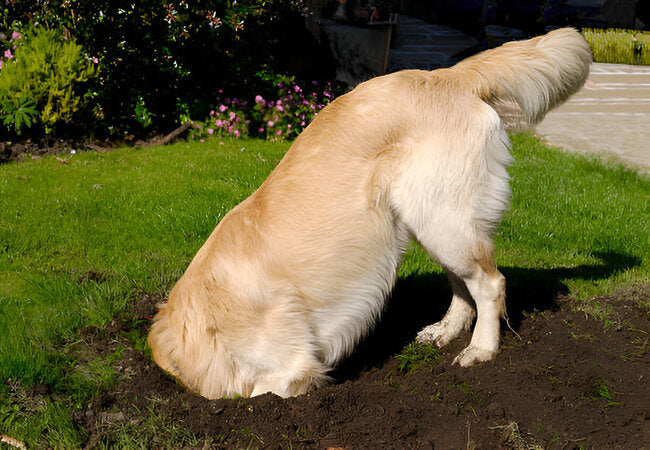How to Stop Dog Digging in 2025 – Vet‑Approved Guide to Identify Causes & Redirect Behavior 🐶⛏️

In this article
How to Stop Dog Digging in 2025 – Vet‑Approved Guide to Identify Causes & Redirect Behavior 🐶⛏️
By Dr. Duncan Houston BVSc
Digging is a natural behavior—our canine companions scratch into soil instinctively. While some holes are harmless, excessive digging can damage your yard, risk escape, or signal stress. In this 2025 vet‑approved guide, we'll explore the *why* behind digging, teach clear detection methods, and give you a comprehensive, easy-to-copy training and management plan—built on kindness, logical structure, and expert insight.
1. Why Dogs Dig 🧐
- Boredom or lack of stimulation: Without enough exercise, play, or attention, dogs invent their own fun—and a yard full of holes can be the result.
- Prey drive: Rodents or underground critters trigger digging behavior in dogs with strong hunting instincts—like terriers.
- Comfort/cooling: Digging to find cooler soil on hot days—or to insulate in extreme temperatures—especially in breeds bred for burrowing.
- Escape attempts: Dogs may tunnel under fences to follow curiosity or perceived freedom.
- Attention‑seeking: Digging becomes a behavior reinforced by your response (even scolding).
- Nesting or protective instincts: Pregnant dogs will dig to create nests, a natural maternal ritual.
2. Identify the Root Cause
- Location & pattern: Fence line? Likely escape/predatory. Flower beds? Likely prey or burying toys.
- Timing & weather: Warm days, midday holes = cooling. Sudden onset? Anxiety or health issue.
- Dog’s age and breed: Puppies and terriers dig more.
3. Veterinary & Environmental Checkups
- Health assessment: Sudden digging or other disruptions may indicate pain, cognitive issues, or anxiety.
- Yard inspection: Ensure no burrowing animals that trigger prey drive.
- Comfort zone: Provide shaded spaces, shelters, water—eliminate physical needs.
4. Management Strategies
- Dig‑proof fences: Bury chicken wire or heavy rocks at fence bottoms to block tunneling.
- Designated dig zones: Sandbox or pit encourages healthy digging—presence of buried toys helps.
- Yard blocks: Use landscaping stones or planters to cover favorite digging sites.
- Rodent control: Humane pest removal reduces prey-driven behaviors.
5. Training & Redirection
- Increase daily exercise: Walk, play fetch, engage puzzle toys—burn energy before yard time.
- Mentally stimulate: Enrichment toys, training sessions, scent games reduce boredom-induced digging.
- Supervise yard time: Stay outside, interrupt digging with a gentle cue (“Leave it”), then redirect to sandbox or fetch.
- Positive reinforcement: Praise and reward calm or digging in approved areas—avoid punishment.
- Teach cue commands: “Leave it,” “Come,” “Place”—give structure in response to trigger.
6. Creating a Dig Pit
- Choose a low-traffic area; fill with soft soil or sand.
- Hide treats/toys to create positive discovery association.
- Consistently redirect your dog and reward engagement in this zone.
7. Handling Specific Digging Types
- Prey-based: Pest control + dig zone >> eliminate target stimuli.
- Escape digging: Fence defenses + structured yard access.
- Stress-related: Consider anxiety relief, calming aids, vet consult.
- Comfort digging: Add shade structures, doghouse, and surfaces to lie on.
8. What Doesn’t Work
- Avoid shock collars—they cause fear, not solutions.
- Avoid post-action punishment—it confuses cause-and-effect.
- Skipping address of root causes is ineffective—dogs will dig elsewhere.
9. Special Scenarios
- Puppies: Naturally curious—redirect to sandbox, supervise frequently.
- High-drive breeds: Terriers, hounds, Malamutes—digging is instinctual. Provide dig pit or structured digging outlets.
10. Quick‑Reference Training Table
| Digging Type | Cause | Intervention |
|---|---|---|
| Prey-driven | Animals underground | Rodent control + dig pit + fence mesh |
| Escape digging | Curiosity/ boredom | Fence reinforcement + supervision |
| Boredom digging | Lack of lights | Exercise + mental toys + training |
| Comfort digging | Temperature regulation | Shade/shelter & dig pit |
| Nesting/pregnant | Maternal instincts | Quiet nesting area & supervise |
11. 📱 Ask A Vet App 2025 Support
With the Ask A Vet app, you can:
- 📹 Upload videos of digging behavior for vet and trainer analysis.
- 🧩 Receive personalized behavior plans tailored to your dog’s digging type.
- 💬 Access live vet and trainer consultations for strategy adjustments.
Expert input supports faster, kinder results—turning digging behavior into guided, positive activity. 🐾📲
❤️ Final Thoughts
Digging is often natural—but excessive or destructive digging impacts homes and gardens. The key isn’t punishment—it’s understanding *why* by assessing location, triggers, and behavior. From thoughtful yard prep, digging zones, increased exercise and enrichment, to redirection and structured training, your dog can learn better outlets. In 2025, let’s harness our dogs’ minds and instincts in positive ways—earning a beautiful yard and a happier, fulfilled pup. 🐶⛏️
Need personalized help? Visit AskAVet.com or download the Ask A Vet app for expert guidance tailored to your dog’s digging behavior.






